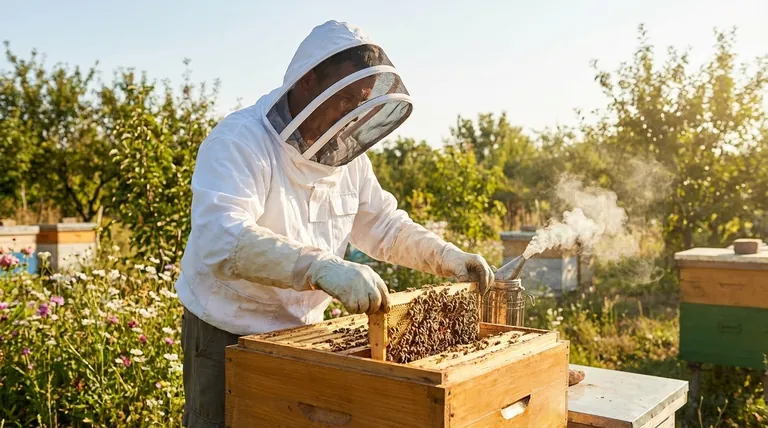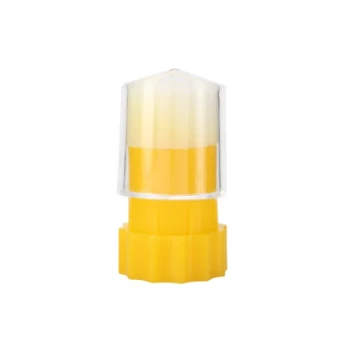In short, a bee jacket is a specialized piece of protective upper-body clothing worn by beekeepers. It is a long-sleeved jacket made from thick, sting-resistant fabric and almost always includes an integrated veil to shield the head and face from bee stings.
A bee jacket offers a critical balance of protection, mobility, and convenience for hive inspections, but it must be understood as one component of a complete safety system, not a standalone solution.

Why a Bee Jacket is Essential Protective Gear
The primary purpose of any beekeeping apparel is to create a barrier between you and the bees. This allows you to work calmly and confidently, which in turn keeps the bees calmer.
Core Function: Sting Prevention
A bee's stinger is typically not long enough to penetrate the thick materials used in a quality bee jacket. This physical barrier is the first and most important line of defense against stings.
Material and Construction
Most bee jackets are made from heavy-duty cotton canvas, polyester-cotton blends, or modern ventilated mesh fabrics. These materials are chosen for their durability and density, making it difficult for a stinger to pass through. Key features often include elastic cuffs and a tight-fitting waistband to prevent bees from crawling inside.
The Integrated Veil
Arguably the most critical feature is the attached veil. Stings to the face and neck are particularly dangerous and painful. The veil, typically a black mesh for optimal visibility, zips directly onto the jacket's collar, creating a secure, sealed enclosure for your head.
Bee Jacket vs. Full Bee Suit
A common decision for a new beekeeper is choosing between a jacket and a full suit. The choice hinges on your comfort level and the type of beekeeping you plan to do.
The Jacket: Mobility and Convenience
A bee jacket, often paired with thick jeans as noted in the references, is easier to put on and take off. It offers more freedom of movement and is less cumbersome for quick hive checks, especially in warmer weather.
The Full Suit: Maximum Protection
A full bee suit is a single garment that combines the jacket and pants. Its primary advantage is the elimination of the gap at the waist, which is the most common entry point for bees when wearing only a jacket.
Understanding the Trade-offs and Limitations
While effective, a bee jacket is not infallible. Understanding its limitations is key to using it safely.
The Critical Gap in Protection
The most significant vulnerability of a bee jacket is the separation between the jacket and your pants. Bees are experts at finding small gaps, and an unsecured waistline is an open invitation. This is why it is always recommended to wear thick, heavy-duty pants and ensure a secure overlap.
Heat and Ventilation
The same thick fabric that stops stingers also traps body heat. In hot climates, working in a standard cotton jacket can be taxing. This has led to the popularity of ventilated jackets, which use layers of mesh to allow for airflow while still preventing stings.
Gear is Not a Substitute for Skill
No piece of equipment can replace the need for calm, deliberate movements when working with bees. A bee jacket provides a safety net that enables you to learn, but your primary goal should always be to work in a way that does not agitate the colony in the first place.
Making the Right Choice for Your Needs
Selecting your protective gear depends entirely on your goals and beekeeping style.
- If your primary focus is quick, routine inspections in a calm apiary: A high-quality bee jacket paired with durable pants may offer the perfect blend of convenience and safety.
- If your primary focus is maximum safety, especially when learning or working with aggressive hives: A full bee suit is the superior choice, as it eliminates the critical vulnerability at the waist.
- If your primary focus is comfort in a hot climate: A ventilated jacket or suit is a worthwhile investment to prevent overheating during hive work.
Ultimately, your protective gear should give you the confidence to work your bees safely and effectively.
Summary Table:
| Feature | Bee Jacket | Full Bee Suit |
|---|---|---|
| Protection Level | Upper body, head, and face | Full body coverage |
| Mobility & Convenience | High (easier on/off) | Moderate |
| Key Vulnerability | Gap at the waist | Minimal (eliminates waist gap) |
| Ideal For | Quick inspections, warmer weather | Maximum safety, aggressive hives, beginners |
Ready to equip yourself or your business with professional-grade beekeeping protection?
HONESTBEE supplies durable, high-quality bee jackets, full suits, and other essential beekeeping supplies and equipment to commercial apiaries and beekeeping equipment distributors through our wholesale-focused operations. Our gear is designed to provide the safety and confidence you need for effective hive management.
Contact HONESTBEE today to discuss your wholesale needs and discover how our protective equipment can benefit your operation.
Visual Guide

Related Products
- Beekeeping Jacket with Hood and Veil for Beekeepers
- Economy Polyester Beekeeping Jacket with Veil and Hat
- Cotton Beekeeping Suit and Round Hat with Veil Bee Keeper Protective Gear
- Heavy Duty Cowboy Beekeeper Hat with Visibility Veil Outdoor Professional Beekeeping Protective Gear
- Beekeeper Cowboy Hat and Veil for Beekeeping
People Also Ask
- What are the advantages of using a beekeeping jacket instead of a full suit? Unlock Speed and Comfort
- Can a bee sting through a bee suit? Understanding Sting-Resistant Protection
- What are the features of an economical beekeeping jacket? Essential Protection for Budget-Conscious Beekeepers
- What are the advantages of a beekeeping jacket? Superior Mobility & Comfort for Routine Hive Inspections
- What should I wear under a bee suit? Essential Clothing for Maximum Protection & Comfort



















